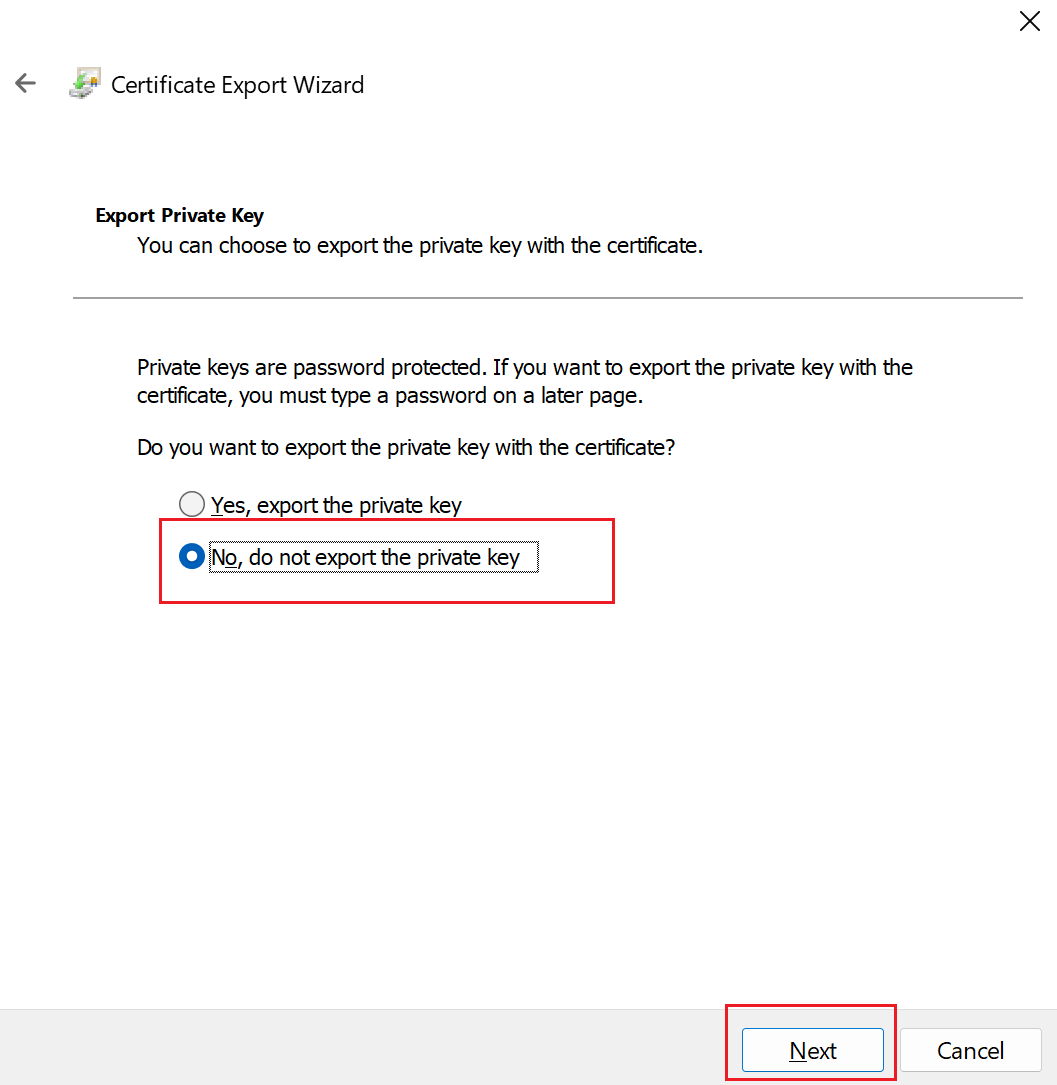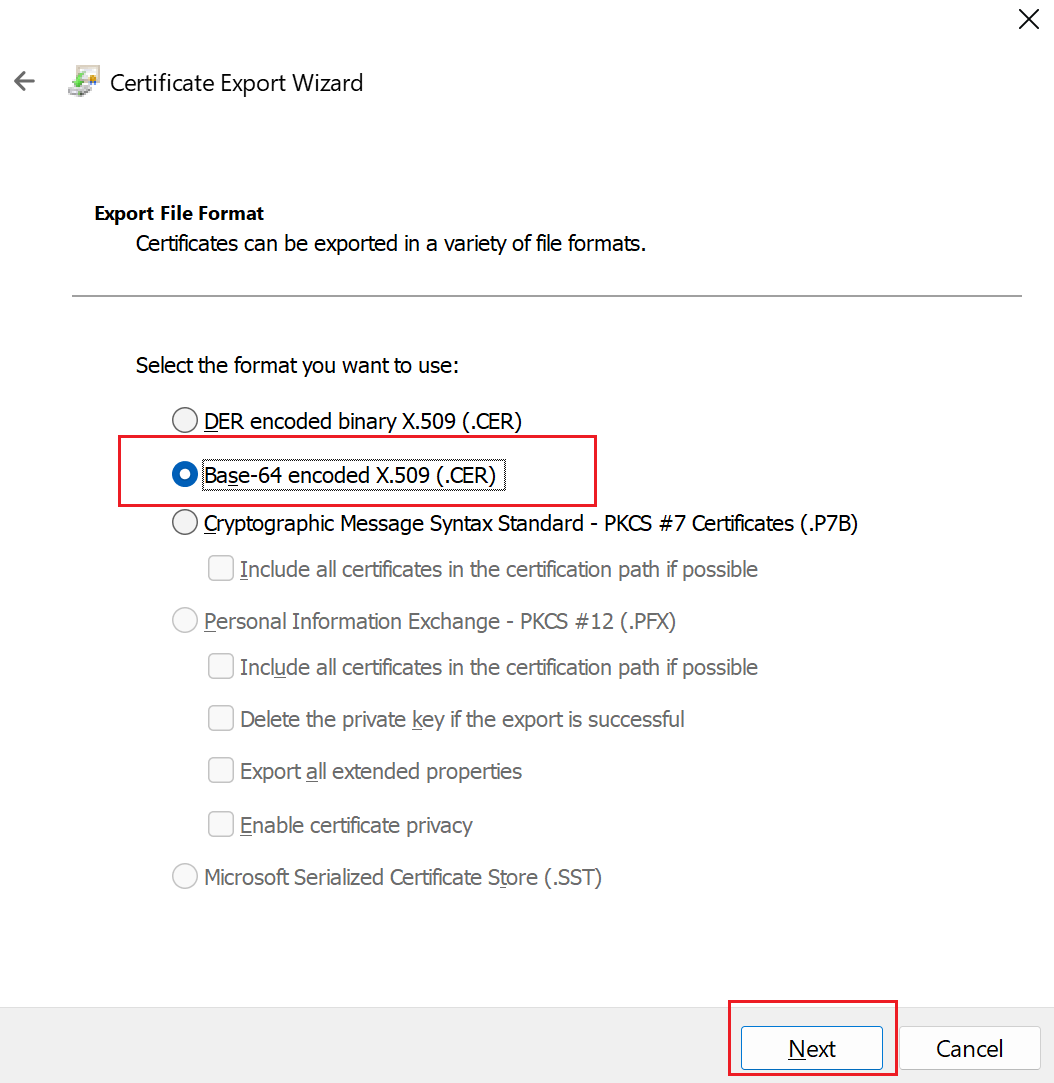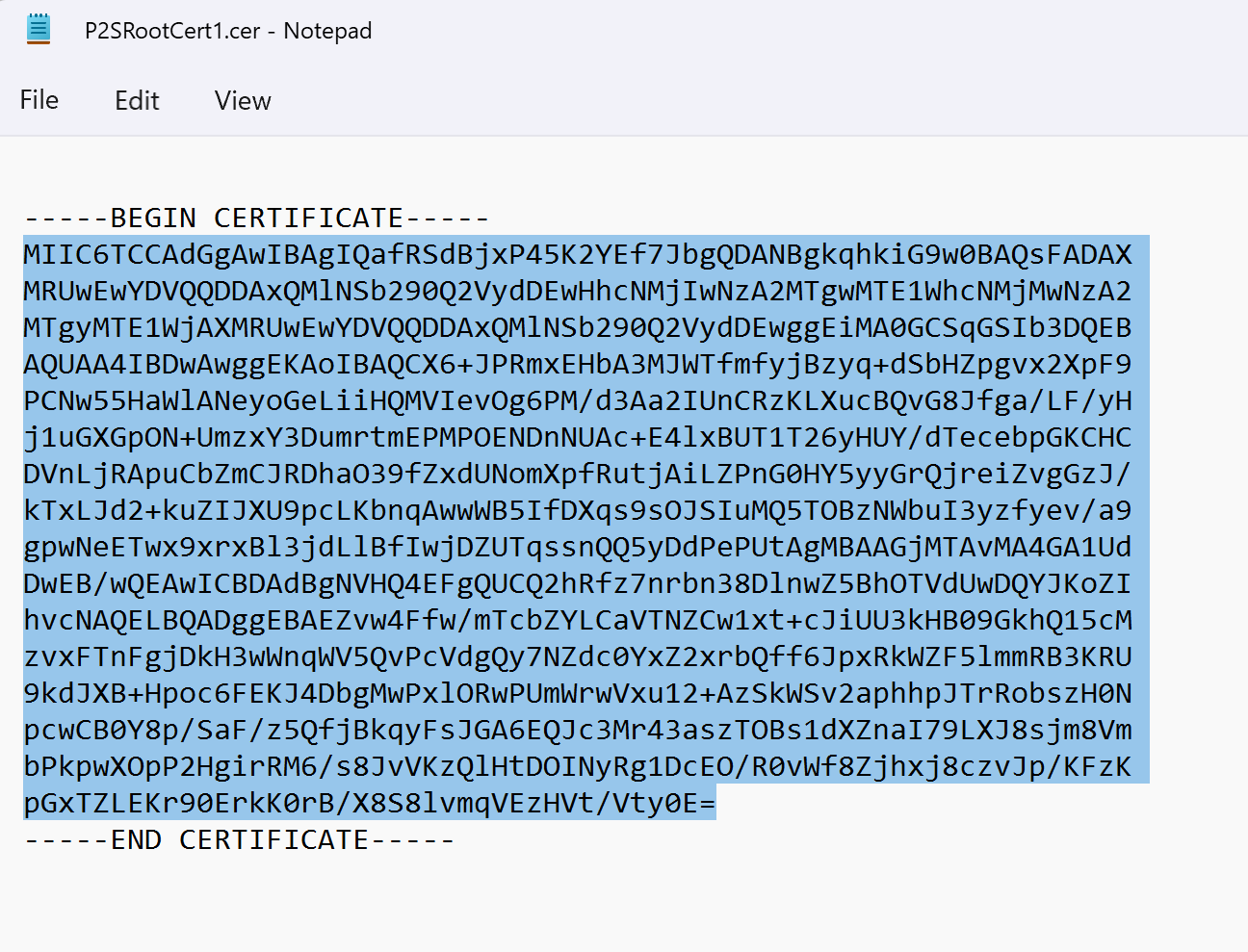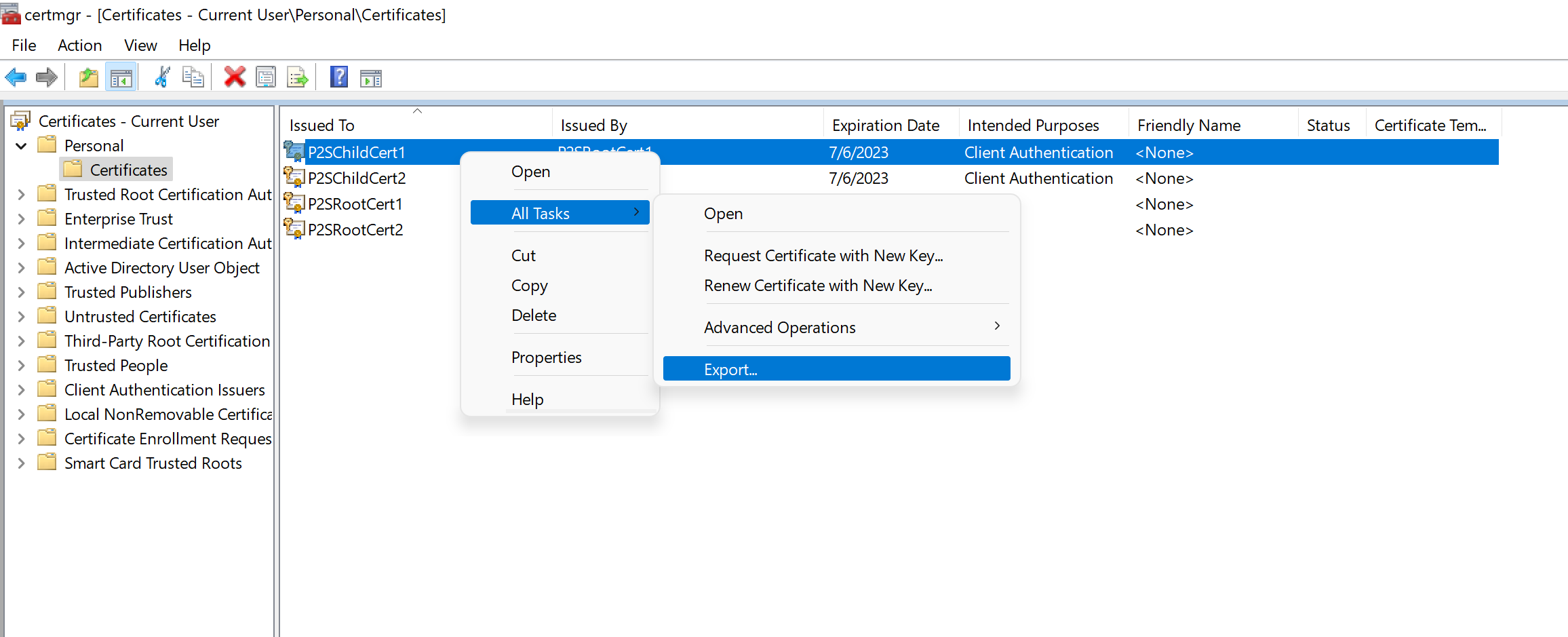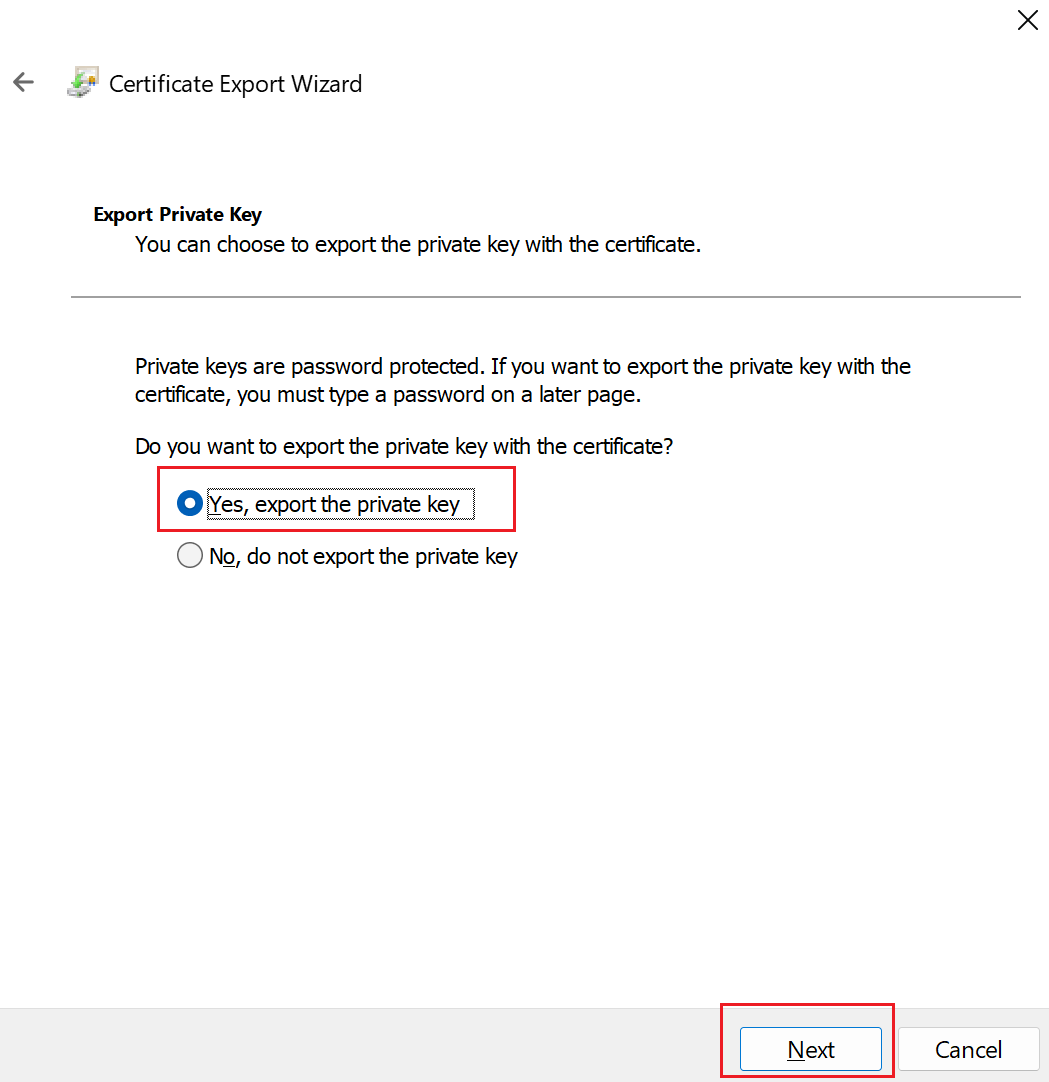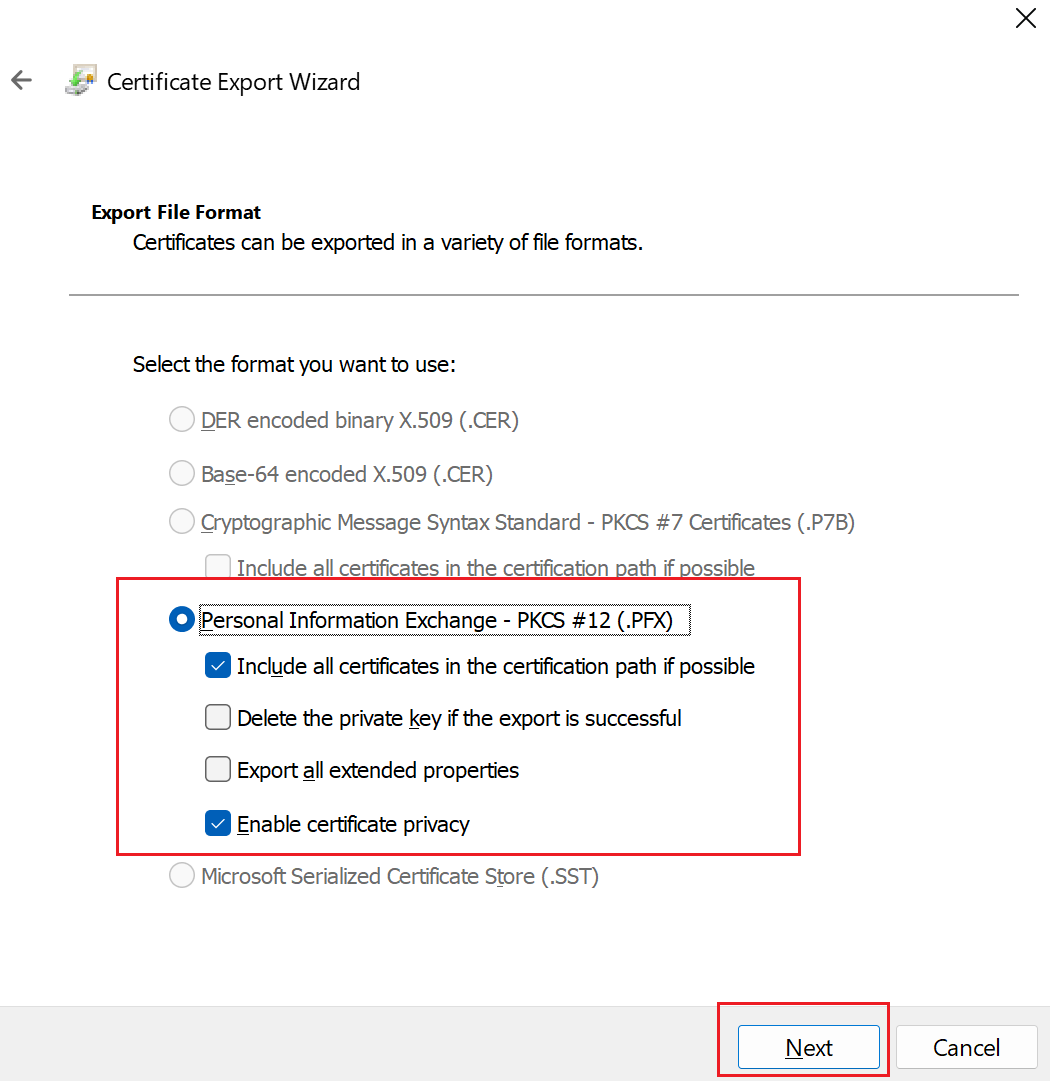Generate and export certificates for point-to-site using PowerShell
Point-to-site connections use certificates to authenticate. This article shows you how to create a self-signed root certificate and generate client certificates using PowerShell on Windows 10 or later, or Windows Server 2016 or later.
The PowerShell cmdlets that you use to generate certificates are part of the operating system and don't work on other versions of Windows. The host operating system is only used to generate the certificates. Once the certificates are generated, you can upload them or install them on any supported client operating system.
If you don't have a computer that meets the operating system requirement, you can use MakeCert to generate certificates. The certificates that you generate using either method can be installed on any supported client operating system.
Create a self-signed root certificate
Use the New-SelfSignedCertificate cmdlet to create a self-signed root certificate. For additional parameter information, see New-SelfSignedCertificate.
From a computer running Windows 10 or later, or Windows Server 2016, open a Windows PowerShell console with elevated privileges.
Create a self-signed root certificate. The following example creates a self-signed root certificate named 'P2SRootCert' that's automatically installed in 'Certificates-Current User\Personal\Certificates'. You can view the certificate by opening certmgr.msc, or Manage User Certificates.
Make any needed modifications before using this sample. The 'NotAfter' parameter is optional. By default, without this parameter, the certificate expires in 1 year.
$params = @{ Type = 'Custom' Subject = 'CN=P2SRootCert' KeySpec = 'Signature' KeyExportPolicy = 'Exportable' KeyUsage = 'CertSign' KeyUsageProperty = 'Sign' KeyLength = 2048 HashAlgorithm = 'sha256' NotAfter = (Get-Date).AddMonths(24) CertStoreLocation = 'Cert:\CurrentUser\My' } $cert = New-SelfSignedCertificate @paramsLeave the PowerShell console open and proceed with the next steps to generate a client certificate.
Generate a client certificate
Each client computer that connects to a VNet using point-to-site must have a client certificate installed. You generate a client certificate from the self-signed root certificate, and then export and install the client certificate. If the client certificate isn't installed, authentication fails.
The following steps walk you through generating a client certificate from a self-signed root certificate. You may generate multiple client certificates from the same root certificate. When you generate client certificates using the steps below, the client certificate is automatically installed on the computer that you used to generate the certificate. If you want to install a client certificate on another client computer, export the certificate.
The examples use the New-SelfSignedCertificate cmdlet to generate a client certificate.
Example 1 - PowerShell console session still open
Use this example if you haven't closed your PowerShell console after creating the self-signed root certificate. This example continues from the previous section and uses the declared '$cert' variable. If you closed the PowerShell console after creating the self-signed root certificate, or are creating additional client certificates in a new PowerShell console session, use the steps in Example 2.
Modify and run the example to generate a client certificate. If you run the following example without modifying it, the result is a client certificate named 'P2SChildCert'. If you want to name the child certificate something else, modify the CN value. Don't change the TextExtension when running this example. The client certificate that you generate is automatically installed in 'Certificates - Current User\Personal\Certificates' on your computer.
$params = @{
Type = 'Custom'
Subject = 'CN=P2SChildCert'
DnsName = 'P2SChildCert'
KeySpec = 'Signature'
KeyExportPolicy = 'Exportable'
KeyLength = 2048
HashAlgorithm = 'sha256'
NotAfter = (Get-Date).AddMonths(18)
CertStoreLocation = 'Cert:\CurrentUser\My'
Signer = $cert
TextExtension = @(
'2.5.29.37={text}1.3.6.1.5.5.7.3.2')
}
New-SelfSignedCertificate @params
Example 2 - New PowerShell console session
If you're creating additional client certificates, or aren't using the same PowerShell session that you used to create your self-signed root certificate, use the following steps:
Identify the self-signed root certificate that is installed on the computer. This cmdlet returns a list of certificates that are installed on your computer.
Get-ChildItem -Path "Cert:\CurrentUser\My"Locate the subject name from the returned list, then copy the thumbprint that is located next to it to a text file. In the following example, there are two certificates. The CN name is the name of the self-signed root certificate from which you want to generate a child certificate. In this case, 'P2SRootCert'.
Thumbprint Subject ---------- ------- AED812AD883826FF76B4D1D5A77B3C08EFA79F3F CN=P2SChildCert4 7181AA8C1B4D34EEDB2F3D3BEC5839F3FE52D655 CN=P2SRootCertDeclare a variable for the root certificate using the thumbprint from the previous step. Replace THUMBPRINT with the thumbprint of the root certificate from which you want to generate a child certificate.
$cert = Get-ChildItem -Path "Cert:\CurrentUser\My\<THUMBPRINT>"For example, using the thumbprint for P2SRootCert in the previous step, the variable looks like this:
$cert = Get-ChildItem -Path "Cert:\CurrentUser\My\7181AA8C1B4D34EEDB2F3D3BEC5839F3FE52D655"Modify and run the example to generate a client certificate. If you run the following example without modifying it, the result is a client certificate named 'P2SChildCert'. If you want to name the child certificate something else, modify the CN value. Don't change the TextExtension when running this example. The client certificate that you generate is automatically installed in 'Certificates - Current User\Personal\Certificates' on your computer.
$params = @{ Type = 'Custom' Subject = 'CN=P2SChildCert' DnsName = 'P2SChildCert1' KeySpec = 'Signature' KeyExportPolicy = 'Exportable' KeyLength = 2048 HashAlgorithm = 'sha256' NotAfter = (Get-Date).AddMonths(18) CertStoreLocation = 'Cert:\CurrentUser\My' Signer = $cert TextExtension = @( '2.5.29.37={text}1.3.6.1.5.5.7.3.2') } New-SelfSignedCertificate @params
Export the root certificate public key (.cer)
After you create a self-signed root certificate, export the root certificate .cer file (not the private key). You'll later upload the necessary certificate data contained in the file to Azure. The following steps help you export the .cer file for your self-signed root certificate and retrieve the necessary certificate data.
To get the certificate .cer file, open Manage user certificates.
Locate the self-signed root certificate, typically in "Certificates - Current User\Personal\Certificates", and right-click. Click All Tasks -> Export. This opens the Certificate Export Wizard.
If you can't find the certificate under "Current User\Personal\Certificates", you may have accidentally opened "Certificates - Local Computer", rather than "Certificates - Current User".
In the wizard, click Next.
Select No, do not export the private key, and then click Next.
On the Export File Format page, select Base-64 encoded X.509 (.CER)., and then click Next.
For File to Export, Browse to the location to which you want to export the certificate. For File name, name the certificate file. Then, click Next.
Click Finish to export the certificate.
You'll see a confirmation saying "The export was successful".
Go to the location where you exported the certificate and open it using a text editor, such as Notepad. If you exported the certificate in the required Base-64 encoded X.509 (.CER) format, you'll see text similar to the following example. The section highlighted in blue contains the information that you copy and upload to Azure.
If your file doesn't look similar to the example, typically that means you didn't export it using the Base-64 encoded X.509(.CER) format. Additionally, if you use a text editor other than Notepad, understand that some editors can introduce unintended formatting in the background. This can create problems when uploaded the text from this certificate to Azure.
Export the self-signed root certificate and private key to store it (optional)
You may want to export the self-signed root certificate and store it safely as backup. If need be, you can later install it on another computer and generate more client certificates. To export the self-signed root certificate as a .pfx, select the root certificate and use the same steps as described in Export a client certificate.
Export the client certificate
When you generate a client certificate, it's automatically installed on the computer that you used to generate it. If you want to install the client certificate on another client computer, you need to first export the client certificate.
To export a client certificate, open Manage user certificates. The client certificates that you generated are, by default, located in 'Certificates - Current User\Personal\Certificates'. Right-click the client certificate that you want to export, click all tasks, and then click Export to open the Certificate Export Wizard.
In the Certificate Export Wizard, click Next to continue.
Select Yes, export the private key, and then click Next.
On the Export File Format page, leave the defaults selected. Make sure that Include all certificates in the certification path if possible is selected. This setting additionally exports the root certificate information that is required for successful client authentication. Without it, client authentication fails because the client doesn't have the trusted root certificate. Then, click Next.
On the Security page, you must protect the private key. If you select to use a password, make sure to record or remember the password that you set for this certificate. Then, click Next.
On the File to Export, Browse to the location to which you want to export the certificate. For File name, name the certificate file. Then, click Next.
Click Finish to export the certificate.
Install an exported client certificate
Each client that connects over a P2S connection requires a client certificate to be installed locally. To install a client certificate, see Install a client certificate for point-to-site connections.
Next steps
Continue with your point-to-site configuration.
- For Resource Manager deployment model steps, see Configure P2S using native Azure certificate authentication.
- For classic deployment model steps, see Configure a point-to-site VPN connection to a VNet (classic).
Feedback
Coming soon: Throughout 2024 we will be phasing out GitHub Issues as the feedback mechanism for content and replacing it with a new feedback system. For more information see: https://aka.ms/ContentUserFeedback.
Submit and view feedback for

